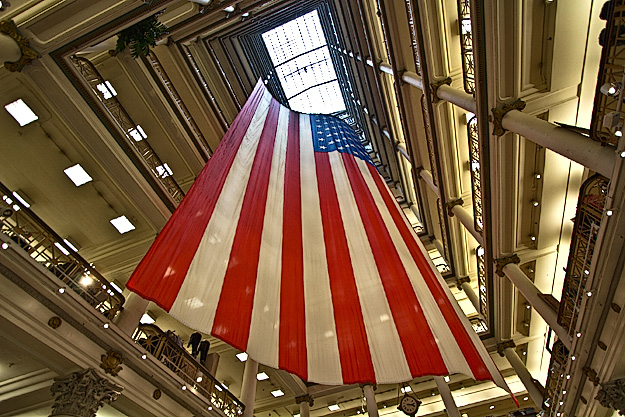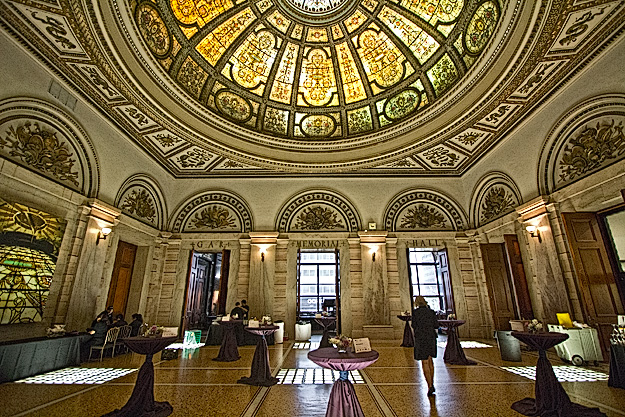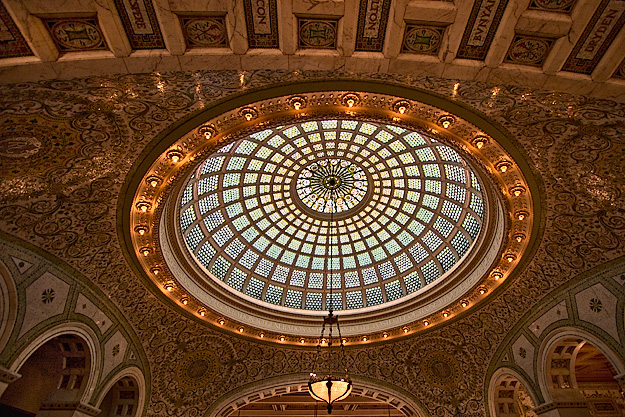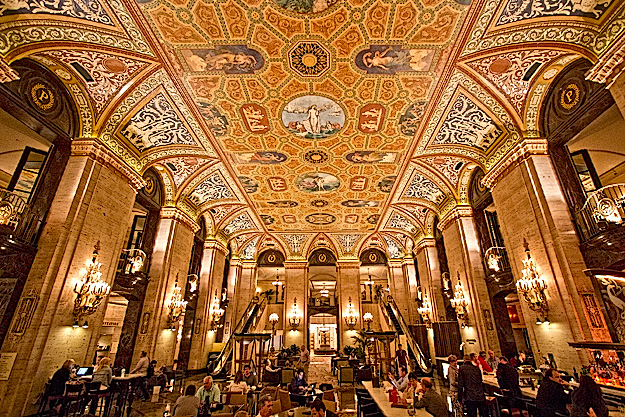It’s fashionable to say that New York is the greatest city in the world, but this Chicago girl prefers the Second City. For the first time in many years, I had an opportunity to spend summer in the Chicagoland area, where my family still lives. As I always do whenever I’m here, I took one of the many walking tours offered by the Chicago Architecture Foundation. Last time I opted for a lunchtime tour of the Chicago Board of Trade Building, which provided a fascinating in-depth architectural look into the art deco skyscraper and allowed me to watch commodities traders screaming out orders in the “pit.” Since I focus on issues of culture, this time I chose the Treasures of Culture and Commerce walking tour in downtown Chicago, which promised to share the stories behind the great architectural landmarks of State Street and Michigan Avenue from the late 19th and early 20th centuries.
So much has changed since I grew up on the south side of Chicago. When I was a child, mom and dad would take my sisters and I downtown for the unveiling of the department store Christmas windows. For days beforehand, the giant windows that front State Street were covered in butcher paper. We’d plaster our noses to those icy window panes, excited beyond words as the paper was peeled away to reveal heaps of toys amidst a wonderland of animated figures.

Those days are long gone, as are many of the original department stores. Mandel’s, where my mother worked as a young woman, is just a memory. Marshall Field & Company, where we had lunch at the Walnut Room at least once each holiday season, is now a Macy’s. The gargantuan Christmas tree that rose seven floors through the atrium, terminating in the center of the restaurant, has been replaced by a huge American flag.

On the top floor of the Chicago Cultural Center, I gazed up at two exquisite stained glass ceiling domes. I couldn’t shake the feeling of having been there before. Suddenly, something clicked; years ago this building had housed the Chicago Public Library, where I had spent many hours studying during my first year of college at what was then the University of Illinois, Chicago Circle Campus.

Even the Art Institute, with its two stately bronze lions flanking the Michigan Avenue entrance, began life as something else. Built in 1893 for the World’s Columbian Exposition, the building was converted to the Art Institute at the end of the fair. Though still being used for the same purpose as when I was a youngster, the museum long ago outgrew its original building. It has seen eight major expansions, the latest being the Modern Wing, which opened in 2009.

More memories bubbled up when we walked into the Palmer House and rode the escalator down to the sunken lobby. Business magnate Potter Palmer risked his reputation and fortune on the belief that State Street would become the heart of downtown Chicago. He acquired much of the land on what was a narrow, unattractive lane, then petitioned the city to reconfigure it as a broad Parisian-style boulevard. Many property owners refused to move their structures back from the street to accommodate this plan, but Palmer got his wish after the Chicago fire of 1871 destroyed all the buildings on State Street, including his new hotel, which he had built as a wedding present for his bride, Bertha.

Never one to give up, Palmer rebuilt, and Bertha set about decorating the hotel in a manner that celebrated her French heritage. She filled it with French impressionist paintings, Tiffany chandeliers, and commissioned the French painter Louis Pierre Rigal to create an immense fresco on the ceiling. That ceiling swept me even further down memory lane. Everything looked exactly the same as it had the day I crossed the lobby in a white ballgown studded with tiny embroidered red roses, to the Empire Room for my Senior Prom. Today the Palmer House is part of the Hilton hotel chain and, although it has undergone a $170 million renovation designed to upgrade the amenities to 21st century standards, the famous lobby retains its original decor. Many things may have changed since I was a child, but with each Architecture Foundation tour I become more convinced that, in the case of Chicago, those changes are for the better.
About the Chicago Architecture Foundation:
The Chicago Architecture Foundation presents more than 85 different tours of Chicago’s neighborhoods and suburbs by boat, bus, trolley, bike, L-train or walking. Volunteer docents lead these tours after completing a graduate-level ten-week training program. Most tours last two hours and fees begin at $5, but an annual membership to CAF – which may be the best deal in the city at $55 – provides members with free, year-long access to any tour other than the River Cruises and bus tours. CAF is located at 224 South Michigan Avenue, Chicago, Illinois 60604. For further information visit www.architecture.org or call 312-922-3432.
Disclosure: I was a guest of the Chicago Architecture Foundation on this tour, however the receipt and acceptance of complimentary items or services will never influence the content, topics, or posts in this blog. I write the truth, the whole truth, and nothing but the truth.

Fantastic write-up! If there were mountains near Chicago I still would be living there. I might be living in Tahoe now, but my heart and soul is still in Chicago. Still my favorite place on earth when it’s not snowing in the mountains.
Hi Alex S. Thank you so much. I do love Chicago. It has so much to offer in every way, but my bones just can’t take the winters there anymore.
As a native Chicagoan now living in Greece, I share the love of the Second City, which to us natives is second to none! Please view my 3D-Stereoscopic photos of Chicago by visiting martylobel.wixsite.com/3d-photography. Sorry, the site doesn’t sell anything!
Hi Martin: Thanks so much for your comments. I looked at your photos of Chicago -hope you received my direct email. I love the city too, and would certainly consider living there except for the winters, which are just too cold for me.
I guess Chicago got to “start again” with its immense fire, but what an architectural job they have done. I was staggered by the beauty and architectural integrity of Chicago in my only visit some years ago and the fact that they preserved a lot of green space.
Hi Mark: You’re absolutely correct, IMO, that one of the things that makes Chicago so very special is its green space along the lakefront. The people who were involved in city planning were absolute visionaries.
I love the magical roof art, its absolutely amazing. Thanks for sharing. Its refreshing!
Thanks Mian – so glad you enjoyed the article.
Goodness … Chicago is definitely one of the world’s great cities, let alone one of the best in America!
It is Uma – I love everything about Chicago but the winters 🙂
Love this! I grew up in a suburb, and have many of the same memories you do, including the Walnut Room over the holidays! And although my parents have lived downtown for many years now, I’ve only recently been to the Chicago Cultural Center- incredible architecture!! Thank you for this “post down memory lane.”
Hi Sarah: You’re very welcome. Going down to the Loop, or to the Gold Coast, is always a trip down memory lane for me, so I’m happy to hear I conveyed that in my story.